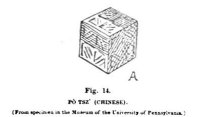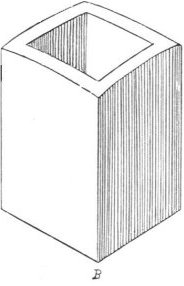
The pò tsz', or covered die, is not, properly, a die at all.
It consists of a small wooden cube (Figure 14-A), which is placed in a square receptacle in the top of a brass prism (Figure 14-C), over which a brass cover [Page 508] (Figure 14-B) fits very closely.

A specimen exhibited by His Highness, the Sultan of Johore in the section of games at the Columbian Exposition consisted of a wooden cube about one-half an inch square, having one-half of each face painted red and one-half white. The prism in which the cube fitted was slightly convex on the bottom, and, when placed upon a smooth surface, could be twirled rapidly.
The game is played by placing the box containing the pò in the center of a square crossed by diagonal lines, which is drawn upon a mat. One of the four divisions of the square is painted red.
The players lay their bets upon the other divisions, and the box is spun rapidly by the gamekeeper, who repeats the operation until it comes to rest squarely with the corners corresponding with the intersecting lines.

The cover is then lifted, and those who have staked opposite the red side of the die win. The banker wins when the red side comes opposite the side of the square painted red.1
There is said to be a current notion, amounting to a superstition among the Chinese in Johore, that if a player stops the box as it is spinning the luck will surely go against him.
Notes: 1. The Manners and Customs of the Chinese of the Straits Settlements, Singapore, 1879, p. 63. The Chinese laborers in the United States are generally unfamiliar with the game.
Last update January 31, 2010